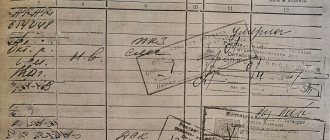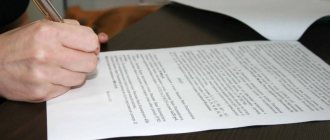Types of encumbrances on real estate
In legal terminology, the concept of “encumbrance” means that, in addition to the owner, third parties lay claim to the property for various reasons. The following types of restrictions are distinguished:
- rent If a tenant lives in the apartment, the new owner cannot make purchase and sale transactions until he evicts;
- rent. The agreement provides for the transfer of ownership to the new owner in exchange for assistance and provision of everything necessary to the current owner throughout the latter’s life;
- mortgage. In accordance with, during the period of debt repayment, real estate is used as collateral;
- arrest. Late payment of bills and collection of debts in court will lead to bans from bailiffs;
- trust management. The ability to dispose is partially transferred to the temporary owner of the property, while the right of ownership remains with the main owner.
Since transactions with encumbered housing are always accompanied by difficulties, it is worth understanding what encumbered apartments are.
Rent
Rent in terms of encumbering living space means the transfer of ownership rights to a third party - the rent payer, who undertakes to pay a certain amount to the second party to the agreement - the recipient of the rent, until his death.
Usually these are elderly single people who, in exchange for maintenance and care, leave their property to strangers. At the same time, the former owner retains the right to reside in the “transferred” territory for life.
The new owner does not have the right to fully dispose of the property transferred to him until the death of the previous owner. That is, in such a situation, the third party limiting the rights of the owner is the recipient of the rent - an elderly person who has transferred the rights to own his property.
Important: the rent payer bears certain risks associated with the “sudden” appearance of the heirs of the previous owner. Before entering into an agreement, you need to make sure that the annuity recipient is truly single.
It is possible to remove encumbrances from the living space under a rent agreement only after the previous owner dies: the new owner of the apartment must transfer through a proxy or bring personally to the MFC the following documents:
- your passport;
- death certificate of a dependent, that is, the recipient of the annuity;
- annuity agreement;
- application for removal of encumbrances from real estate.
It usually takes from 5 to 30 days for restrictions to be lifted. If everything is in order with the documents, after this period the rent holder will receive an extract, where an empty field will be left in the “encumbrances” column.
Mortgage
When applying for a mortgage, the purchased property acts as collateral to the bank. Accordingly, the third party in this situation is the financial institution from which the loan was taken. The housing will be encumbered until the debt is fully repaid, that is, the owner of the apartment will not be able to sell or rent it out until the mortgage is fully repaid.
Important: each bank puts forward its own list of restrictions on collateral. In some cases, without agreement with the lender, owners do not even have the right to carry out repair work.
After the debt is repaid, the encumbrances on the apartment are removed. If the apartment needs to be sold, then the debt can be paid by both the owner-seller and the buyer. In the latter case, a corresponding agreement is concluded between the parties to the purchase and sale transaction - the buyer pays off the mortgage, and transfers the difference between the cost of the apartment and the debt to the bank to the seller.
After the mortgage is repaid, you need to obtain a certificate from the bank about the closure of the loan, as well as written consent to remove the encumbrance from the apartment. The received papers, along with your passport, certificate of ownership and loan agreement, must be submitted to the MFC. After reviewing the papers, you will be notified that all restrictions on the apartment have been lifted.
It is worth noting that not all banks require the owner to submit documents to remove restrictions after paying off the mortgage. For example, a credit and financial structure such as Sberbank removes the encumbrance automatically: the procedure occurs relatively quickly - within 2-3 weeks from the moment the debt is fully repaid.
Rent
If the lease agreement is concluded for more than a year, information about this is recorded in Rosreestr. The tenant gets the opportunity to dispose of the housing at his own discretion, within the framework of the concluded agreement, but the landlord still remains the formal owner.
The person limiting the rights of the owner is the tenant. It is noteworthy that without his consent, the owner has the right to sell the rental property, but cannot kick out the tenant before the expiration of the contract. In this case, the removal of the encumbrance occurs after the end or early termination of the agreement between the parties.
As a rule, after the expiration of the contract, restrictions on the apartment are removed automatically, that is, the owner does not need to submit a special application for this. However, in controversial situations, you may still need to contact Rosreestr with a standard set of papers:
- passport;
- lease contract;
- early termination agreement (if any);
- certificate of ownership;
- statement.
The consideration of the application, as in the previous case, will take from 5 to 30 days.
Guardianship
If minors have rights to an apartment—usually the owner’s children—then the owner will be able to dispose of the living space only with the consent of the guardianship authorities.
This does not mean that the owner will not be able to sell or rent out his property until the children grow up - the guardianship authorities will check that the rights of minors will not be violated when selling the property, and will give consent.
Trust management
Encumbrance on an apartment based on a trust management agreement is similar to encumbrances due to an agreement between the tenant and the landlord. The owner transfers the rights to manage the living space to a trustee, while losing a number of rights to dispose of his property.
Until the contract expires, the owner of the property will not be able to sell it, donate it or rent it out - the list of restrictions depends on the conditions specified in the contract. Restrictions are also removed automatically after the agreement expires.
Arrest
When real estate is seized, as well as with other types of housing encumbrance, the owner loses part of his administrative rights. The only difference is that in some cases of arrest, the owner is prohibited from being on the territory of the seized property, while, in other types of encumbrance, the owner has every right to live in the apartment.
It is worth noting that such cases are exceptional, for example, when there is a threat of damage or loss of property. Under standard conditions, upon arrest, the owner can continue to live in his home.
The seizure of real estate is most often associated with either refusal to fulfill debt obligations, usually to a bank on a loan, or with legal proceedings regarding encumbered property, for example, in the process of dividing property between spouses.
In the first case, the arrest will be lifted after all debts are settled. The debtor needs to obtain a certificate from the bank stating that the loan has been repaid and send the documents to the FSSP. In the second case, the encumbrances will be removed after the completion of the trial.
What is an encumbrance?
An encumbrance is a partial restriction of the owner’s rights to dispose and use an apartment or other property. Such a measure may occur by virtue of law or contract . There are several types of encumbrances:
- rent;
- pledge;
- trust management;
- arrest.
Encumbrance can be either voluntary (for example, when an owner pledges his property to take out a loan from a bank) or forced (seizure of real estate for debts). Information about the absence or presence of encumbrances is stored in the Rosreestr database, and is also required to be indicated in the extract from the Unified State Register of Real Estate .
The encumbrance is necessarily imposed as a result of loan obligations : the bank receives some rights to the pledged property and, in the event of the borrower's insolvency, will be able to partially compensate for its risks. This means that while an encumbrance is placed on the apartment, the borrower will not be able to sell it, rent it out, or remodel the apartment without the bank’s permission.
Only after the mortgage is paid off will the credit institution lose all legal rights to the living space , and the owner will be able to fully exercise his right to sell, exchange or donate property.
When is the mortgage encumbrance removed?
It is possible to remove the mortgage encumbrance from an apartment at the MFC after full repayment of the mortgage obligations. Moreover, full settlement with the credit institution and repayment of the debt does not mean that the burden will be lifted automatically. To do this you will have to perform a series of sequential actions.
The bank issues a confirmation document, a mortgage for the apartment, after the borrower repays the debt. Next, 2 applications to the registration chamber will be required: from the banking organization and the borrower. The application can be from the borrower, from the bank or jointly. A banking organization can independently send a statement that the borrower no longer has obligations to it. Rossreestr fills in new data in the Unified State Register. The process of removing the burden is considered completed after this is entered into the Unified State Register. It can be legally removed by both the homeowner and an employee of the banking organization where the loan was repaid by submitting an application.
A new entry is made in the Unified State Register within three days after the application is received by the Russian Register. After the registration entry is made, the mortgage becomes invalid. They put a repayment mark on it and, if desired, return it to the former borrower. After this, the owner can fully dispose of the property without obtaining permission from other persons. The procedure for removing a mortgage encumbrance at the MFC involves submitting documents to a branch of the center, which then forwards them to the addressee. Now a person has access to all options for making real estate transactions.
After receiving the extract, you should check all your data to see if your passport details and full name are entered correctly and without errors. Check that there is information that there are no debts. On the Internet, through the websites of Rosreestr and the Public Cadastral Chamber, you can additionally check and clarify whether all the specified information has been entered into the database. The received document must be kept, as it is confirmation of the owner’s rights.
How to remove mortgage encumbrances at the MFC: step-by-step instructions
When there are several months left before the full fulfillment of financial obligations to the lender, many Russians begin to be interested in the question of removing the mortgage encumbrance at the MFC. In fact, it is enough to follow a certain algorithm of actions:
- Visit to the bank and submit an application for a mortgage with a note about the payment of the loan. An alternative option is a joint visit to the lender and mortgagor at the My Documents branch or Rosreestr;
- Find the nearest MFC and make an appointment with a specialist, choosing a convenient date and time. If the pre-registration service is not available, visit the center and take an electronic queue coupon;
- Wait until your number appears on the display and go to a specialist. Give him the mortgage note, allowing him to verify the presence of the necessary notes, and fill out the application form;
- If there are no errors, receive a receipt containing a unique request number and the estimated date of service readiness;
- Wait for the date specified in the receipt and make a second visit to the MFC to receive a new extract from Rosreestr.
After completing the procedure, the applicant becomes the full owner of the property and can dispose of it at his own discretion. In this case, we are talking about the possibility of making any transactions, including sale, exchange, rental and other actions.
Terms of provision of services at the MFC
Depending on the individual circumstances of the case, the period for getting rid of restrictions can be 3-5 days. When it comes to a standard or military mortgage, most often the paperwork takes 72 hours. Citizens who purchased housing under a shared participation agreement in construction will have to wait about 5 days. In some cases, the time frame may increase by a day or two, due to the sending of documentation.
If a credit institution offers you not to worry about removing the encumbrance, since the bank is ready to independently resolve all issues related to filing the relevant application, it is better to refuse. On the one hand, the borrower’s initiative will allow you not to think about a visit to the MFC and other organizations, but on the other hand, it can last a long time.
Amount of state duty in 2021
Citizens interested in the financial side of the issue will be pleased to know that removing a mortgage encumbrance at the MFC does not require payment of a state fee, so there is no need to worry about additional expenses.
Features of the procedure
Registration of a mortgage is the final stage of purchasing real estate on credit, which represents the inclusion of data about the property being purchased and the conditions for its acquisition in the database of the unified state register. This procedure confirms the transaction at the state level and protects the rights of all parties to the mortgage agreement. By law, this responsibility is assigned to Rosreestr. And the registration of mortgages is carried out by the territorial body of the federal state registration and cadastre service - the registration chamber.
In addition to the agreement with the bank, Rosreestr can register a purchase and sale agreement for property between the seller and the buyer. Thus, the seller reduces its risks by officially placing an encumbrance on the buyer until full payment of the contract price.
However, it should be borne in mind that not all real estate can be included in a single Rosreestr. Such objects include: dachas, land plots that are state property and plots not allocated from public property, premises intended for business activities, isolated rooms. Also, ships and aircraft, as well as real estate that cannot be assessed due to various circumstances, are not registered.
Depending on the type of mortgage, the procedure for registering it differs.
Legally, there are 2 types of mortgages:
- By virtue of the contract. The collateral for the loan is the borrower's existing housing. With a contractual mortgage, there is no need to confirm the purpose for which the loan is taken, and the terms of the loan are specified in a separate agreement. This type of mortgage is a certain risk for the bank, since it acquires rights to the collateral property only after the mortgage agreement is registered, which occurs within three months allotted by law. To protect themselves with a negotiated mortgage, banks require the borrower to provide guarantors for the loan and set an increased interest rate for the period of registration of the agreement.
- By force of law. The most common type of mortgage. In this case, the borrower takes out a loan from the bank to purchase a home, which is registered as the buyer’s property and at the same time becomes a security deposit for the funds taken. Mandatory conditions are a change in the owner of the property and the provision of a loan for the purchase of housing from the bank's targeted funds, which can be issued to the borrower only upon provision of one of the following documents:
- agreement of shared participation in the construction of a house;
- contract of sale;
- agreement for the assignment of rights to real estate.
There are 4 main differences between one type of mortgage and another:
- The presence of a bank representative when registering a mortgage is required only when lending by virtue of an agreement;
- A mortgage by force of law exempts the bank from paying state duty;
- With a legal mortgage, the collateral is the housing purchased with loan funds, and with a contractual mortgage - any real estate of the borrower;
- In the legal form, the registration of the mortgage agreement is carried out simultaneously with the registration of the borrower’s ownership of the purchased apartment, and in the contractual form, the purchase and sale agreement is registered first, and then the mortgage agreement.
State duty for registration of mortgage and apartment ownership
Registration of ownership of a land plot: citizens – 350 rubles.
The table shows the amount of the state duty when applying for a mortgage: Object Individuals Legal entities Mortgage apartment 2000 rubles 22000 rubles Land plot 350 rubles - Mortgage agreement 1000 rubles 4000 rubles Payment In practice, payment of the state duty is carried out before submitting the necessary documents.
State fee for registering a mortgage agreement
The package of documents in the prescribed form must be accompanied by a receipt indicating the fact of depositing funds to pay the state duty.
Note! Before depositing money, you should receive a document that will indicate the current details and bank accounts for transfers. This information may change, so searching for it on the Internet is not recommended.
The amount of the state fee for registering a mortgage agreement in relation to legal entities is completely different.
Thus, to enter information about a residential mortgage loan agreement into the Unified State Register of Real Estate, you will need to pay at least 4,000 rubles. And registration of an additional agreement will cost 600 rubles for each application.
State duty for mortgage registration
For example, when changing documents for a mortgage, changing entries in the register is a service, the cost of which is determined in the amount of 200 rubles. Registration of property rights costs several times more – 2000 rubles.
To register the agreement, you must pay a fee equal to 1000 rubles. To receive an extract from the register means to pay 750 rubles, and for its electronic version you will have to pay only 300 rubles; when transferring a loan, the payment amount will be 1600 rubles.
Registration deadlines
The deadlines for registering a mortgage are strictly regulated by the federal law “On Mortgage” and depend on the type of real estate.
Thus, the legislation allocates 5 days for registering a mortgage for any residential premises and 7 days for non-residential premises and land plots.
If a non-residential premises or plot is registered on the basis of a notarized transaction, then the registration period is also only 5 days.
It should be kept in mind that registration with Rosreestr will take 2 days longer if documents are submitted to a multifunctional center. This additional time is allocated for couriers who pick up documents from the MFC and take them to the registration authority, and then bring them back.
Documents for removing the encumbrance
To remove the encumbrance from an apartment, you need to prepare an impressive list of documents. For convenience, we divide it into 2 categories:
- Main documents:
- statement from the owner;
- his passport;
- title document for the apartment;
- a receipt indicating payment of the state fee.
- Additional documents (depending on the form of encumbrance imposed on the real estate).
The absence or incorrect execution of even one document is grounds for refusal to remove a previously imposed encumbrance on the apartment.
Additional documents
They confirm that the encumbrance has in fact been eliminated. The list of additional documentation determines the type of restriction imposed:
- arrest,
- rent,
- mortgage,
- trust management,
- rent
Let's consider each of the above options in more detail.
With a mortgage
A fairly large number of apartments in Russia are purchased with a mortgage. The use of borrowed funds is a profitable solution, but it has its drawbacks, one of which is the imposition of an encumbrance on real estate.
It will be possible to remove the restriction in the form of a mortgage after its final repayment. In this case, it is necessary to prepare the following set of documents:
From the bank:
- certificate of full repayment of the mortgage debt and accrued interest,
- statutory documentation of the credit institution,
- mortgage note on completion of settlements with the lender,
- deed of transfer.
From the borrower:
- statement,
- passports of other apartment owners,
- title document for the property.
Upon arrest
Such a measure can be applied exclusively by the court in the presence of a statement of claim from the housing and communal services (ground - large debt in payment of rent and utility bills) or a petition from law enforcement agencies and the Federal Bailiff Service (ground - compensation for material damage caused by a crime).
Seizure provides for a complete ban on the exercise of any authority to dispose of the apartment. To remove it, it is necessary to pay off the resulting debts, penalties and fines or fully compensate for the material damage caused.
Required documents (depending on the basis of arrest):
- a receipt from the housing and communal services confirming the absence of debts and other claims against the owner of the apartment;
- a document from the bailiff who seized the real estate regarding the fulfillment of the requirements;
- a certificate from law enforcement agencies stating that all material damage caused has been compensated to the injured party.
One of the documents is attached to the application, after which it is sent to the court for consideration. The arrest is lifted by issuing an appropriate court order. It must be transferred to the Unified State Register of Real Estate to eliminate the encumbrance.
With rent
This type of encumbrance provides for the transfer of rights to dispose of an apartment to third parties, while the right to use the real estate remains with its actual owner (for example, an elderly person undertakes to transfer the apartment to a third party after his death for payments in cash or in kind, constant care, etc.) .
Note! Rent is a type of encumbrance that is subject to removal from the apartment only after the death of the legal owner.
An exception to the general rule is the presence of a court decision declaring the annuity agreement void due to the incapacity (limited legal capacity) of the party. To remove a lien upon the death of the legal owner, a death certificate will be required.
In case of trust management
If the legal owner of the apartment cannot or does not wish, due to certain circumstances, to dispose of the property independently, then he has the right to transfer his powers to a third party (trustee).
To remove the encumbrance from an apartment, you will need to prepare one of the following documents:
- death certificate of the person appointed as the trustee - for fixed-term and perpetual trust management agreements;
- agreement of the parties to terminate the contract - when concluding a perpetual trust agreement;
- a court decision declaring a previously concluded agreement void or invalid.
If you do not have any of the above documents, but a fixed-term agreement has been concluded, then all you can do is wait - the encumbrance on the apartment will be lifted as soon as the agreement loses its force.
When renting
The conclusion of a lease agreement limits the owner’s powers related to the disposal of the apartment: in particular, he cannot alienate the property (sell, donate, exchange, etc.). Typically, lease agreements are concluded for a certain period, after which the encumbrance is automatically lifted.
If the lease agreement has not expired, then to remove the encumbrance you will need to provide one of the documents:
- a court decision to terminate the lease agreement due to failure of one of the parties to fulfill its assumed obligations;
- a court decision declaring a previously concluded lease agreement void or invalid;
- another document confirming the termination or termination of the lease agreement (for example, a death certificate of the tenant).
How to cancel an encumbrance
The lender is interested in registering encumbrances on real estate, but removing them is the task of the borrower. To cancel a pledge record, you need to contact the Rosreestr branch at the location of the property.
In this regard, it is worth explaining whether it is possible to remove the encumbrance from an apartment in the MFC while in another city, and how to do this. In such cases, the law provides for filing an application by proxy. Information exchange and data transfer online are provided for notaries.
You can issue a power of attorney to remove restrictions from an apartment from any notary. The document is translated into electronic form, certified by a qualified electronic signature and sent to a notary in the recipient’s region.
The attorney receives an equivalent power of attorney at the location of the property and, based on it, submits a completed form to remove the encumbrance on the apartment to the MFC or Rosreestr along with documents to lift the ban.
When can the procedure be initiated?
Depending on the type of restriction, a list of documents is regulated and the period for its removal is calculated:
- Seizure of property. The encumbrance is lifted if there is a resolution to terminate the proceedings, in accordance with.
- Mortgage – after payment of the amount specified in the loan agreement and the mortgage from the bank, based on a certificate of repayment of the loan debt.
- Lease or trust agreement. At the MFC, the encumbrance of the DDU can be removed upon expiration of the agreement.
- Rent. The restrictions will be lifted after the contract is declared invalid in court or the new owner acquires the right of ownership.
Mortgage and removal of encumbrances in the MFC
When an encumbrance on an apartment is imposed upon concluding a mortgage agreement, the legislation provides for the possibility of its removal at the MFC, subject to:
- full repayment of loan obligations;
- mutual agreement between the pledgor and the bank to lift the ban;
- submitting a statement of absence of debt to Rosvoenipoteka.
When foreclosure is applied to the collateral, the ban is automatically lifted.
The process of canceling an entry in the USRN occurs on the basis of an application and confirmation of fulfillment of loan obligations. Documents are sent or handed over in person to the territorial office of the MFC. The applicant is given a receipt of their acceptance.
Deadlines for lifting the ban at the MFC
In accordance with Federal Law No. 210, the provision of services for the removal of encumbrances is carried out according to the “single window” principle. The specialist is only authorized to accept documents and transfer them to Rosreestr, so the waiting period for a response in the absence of errors and false information in the application is 3-5 working days.
Grounds for refusal to cancel an encumbrance
In some situations, it will not be possible to lift the ban on the disposal of an apartment. Main reasons:
- the identity of the applicant has not been established;
- not all documents have been provided;
- the obligations guaranteed by the pledge are not fully fulfilled;
- documents contain errors or inaccurate data.
The law allows appealing a refusal through administrative and judicial procedures. The State Services website contains a form through which the applicant can describe the situation, justify his point of view and provide evidence of the illegality of the refusal.
List of documents for removal of encumbrance
The time has come to discuss what documents are needed at the MFC to remove the encumbrance from the apartment. The general list for registering the removal of collateral consists of:
- passport or other identification document;
- certificates of ownership;
- mortgage or pledge agreement;
- court decisions on debt collection or orders to initiate enforcement proceedings;
- certificates of absence of debt or a court decision on exemption from payment;
- confirmation of payment of state duty.
Depending on the basis for imposing encumbrances, the list of documents may vary slightly.
Government duty
As with the registration of encumbrances, payment of a state fee is required for their removal. In accordance with paragraph 27 of Art. 333 of the Tax Code of the Russian Federation, in order to remove the encumbrance from an apartment in the MFC, the price is:
- for individuals – 350 rubles;
- for legal entities – 1000 rubles.
Obtaining an extract from the register through the MFC
All information found in the Unified State Register of Real Estate is open and accessible, not counting private information. You can obtain information about the removal of the encumbrance by contacting the territorial office of the MFC. To do this you need:
- Make an appointment in advance by calling the hotline, online on the website or
- Submit the application and package of documents to the specialist.
- Receive a receipt.
- Control by receipt number
- After 3-5 days, receive an extract about changes to the Unified State Register.
After the document is issued, the encumbrance is considered lifted.
Get an extract from Rosreestr
To cancel the encumbrance, the applicant can apply directly to Rosreestr, which is authorized to maintain the Unified State Register of Real Estate. Upon request, an extract is issued to the copyright holder within 3 days.
An application for its issuance can be submitted in person, during field service, or by mail. It is possible to order an extract using the form on.
The owner has the right to receive information about everyone who was interested in his property and requested any information, including about encumbrances.
You can check whether the encumbrance has been removed on the page
Read more about obtaining an extract in the article “How to find out if there is an encumbrance on an apartment.”
Cancellation of mortgage encumbrance through State Services
Using the online service, the owner can make changes to remove the encumbrance in the Unified State Register. To do this he must:
- Register on the site, receive a login and password.
- Log in to your personal account, which stores all data about the ordered services and the status of their implementation.
- Open the “My objects” section, where all the applicant’s property is reflected.
- Select the method of receiving the service.
- Having received notification of the date and time of reception, provide a set of documents to the selected department.
The status of the application is checked using the “Notifications on Applications” tab or the application itself.
- Receive an extract or refusal to make changes.
- In case of refusal, send a complaint pre-trial.
This simple algorithm will help property owners figure out how to remove the encumbrance through the State Services website.
Having received an extract from the Unified State Register of Real Estate, the owner again acquires the right to dispose of his property without approval from anyone: sell, donate, exchange, and so on.
The essence and necessity of the procedure
To remove the encumbrance from an apartment or house, you must fully repay the mortgage loan, including accrued interest. This will allow you to freely dispose of real estate: sell it, exchange it, and also give it as a gift.
Advertising from partners
The encumbrance on the apartment is removed by the territorial body of the Federal Service for State Registration, Cadastre and Cartography (Rosreestr). However, it is valid only on the basis of an application sent by the owner of the property to the MFC.
The registration record of the mortgage and the introduction of encumbrances in relation to real estate is contained in the Unified State Register of Real Estate (USRN). You can find out whether a restriction has been applied to your home online on the Rosreestr website, as well as by ordering an extract from the Unified State Register of Real Estate.
How is registration of encumbrance carried out?
The Unified State Register contains information about buildings, structures, parking spaces and other objects, the movement of which is impossible without changing their purpose. Since an encumbrance is the security of obligations, such as a loan or debt, on the basis of Art. 131, restrictions on property rights are also registered in this database.
Since there is no exact list of documents for registration in the legislation, it is possible to impose an encumbrance on an apartment in the MFC on the basis of only an application. It is drawn up on paper or electronically in accordance with.
Other documents are requested in the manner of interdepartmental cooperation, in accordance with (Federal Law No. 210).
A fee is charged to individuals and legal entities for registration of encumbrances.
According to Art. 333, registration of an encumbrance on an apartment at the MFC will cost 2,000 rubles if the application is submitted by an individual, and 22,000 rubles if an organization applies. It is not necessary to provide a receipt for payment of the fee. This information enters the information system on state and municipal payments (GIS GMP).
Registration actions are carried out both with the issuance of an extract from the Unified State Register and without it. The extract can be received on paper in person, ordered by mail or by email.
Service cost
There is no need to pay additional fees for the MFC employee to accept documents. There is no state fee for removing the encumbrance from a mortgaged apartment . The entire procedure is free of charge. You will only need to pay for issuing an extract from the Unified State Register. Its cost in paper form is 400 rubles. For a certificate in electronic format, a fee of 250 rubles is charged. You can deposit the required amount directly at the MFC branch, or use the bank transfer service after receiving a list of required documents.
Required papers
To remove the encumbrance from a mortgaged apartment, you will need to provide the following documents to the MFC:
- completed application. You can get it from the bank or enter the information into it yourself. If a person has difficulties filling out an application, then he needs to contact an MFC specialist for help;
- ID of a citizen of the Russian Federation and its photocopy;
- a bank bond certifying full payment of the mortgage loan.
If the interests of the borrower are represented by a third party, then it will be necessary to issue a notarized power of attorney confirming the client’s fulfillment of his obligations.
Terms of service provision
To remove the mortgage encumbrance through the MFC, you need to prepare documentation. After accepting the documents at the MFC, the specialist sends the package to the registration chamber. It may take about a week for the documentation to be sent and reviewed. You can find out about the readiness of documents through the government services website and by calling the hotline.
If the bank unilaterally sends and forwards a statement that it no longer has financial claims against the borrower, the process will take longer. The borrower will have to wait about two weeks.
The period for removing the mortgage encumbrance at the MFC will take less time than when sending an application by the bank.
How to find out readiness
To find out about the readiness of your extract, you need to refer to the receipt issued to you by a specialist at the multifunctional center after accepting the documents. Each receipt has a number by which you can track the status of the application. To do this, you need to go to the official website of the multifunctional center. The number is in the upper left corner. The service is available around the clock. If you cannot connect to the Internet, you can also find out about the status of your request by calling the hotline.
Further actions
Upon completion of all procedures, the owner of the property is faced with the question of what to do after removing the encumbrance from the apartment. Since the living space no longer belongs to the mortgagee, the owner can dispose of it at his own discretion:
- sell;
- bequeath;
- give;
- register third parties and more in it.
At the same time, he does not need to obtain permission from third parties for these actions. That is, the owner becomes the sole, full owner.
Why is this necessary?
Some owners think that it is not necessary to remove restrictions after a change in ownership. In fact, you need to start the process of clearing the record of restrictions as early as possible. This will avoid problems in the future disposal of housing.
For example, the bank where the loan was issued may go bankrupt. Then, to remove the encumbrance, the apartment owner will have to look for an authorized person who has the right to represent the interests of the bankrupt organization.
Upon completion of all registration actions, the owner can decide what to do next when the encumbrance on the apartment is removed.
Refusal and appeal
If the mortgage loan is fully repaid, the person cannot be refused to remove the encumbrance. The reasons for refusal to formalize the removal of encumbrance are as follows:
- Debt obligations still remain. If the bank that issued the mortgage loan was liquidated, this does not mean the cancellation of mortgage payments. The MFC must provide a certificate from the Unified State Register of Legal Entities and a document certifying the partial transfer of the collateral to the new creditor;
- If a person participates in shared construction, the developer does not always issue an encumbrance on the object. In this case, the refusal to remove the encumbrance will be legal, because it is impossible to remove something that does not exist;
- the applicant provided an incomplete list of documents or made errors in them.
It is necessary to carefully check the submitted documents, since the slightest blots in them will lead to refusal.
Appeal
Errors in the operation of the MFC are caused by human factor. Complaining about a problem must begin by writing a complaint about the actions of a specific employee. You can leave it with the administrator. If the violations are gross and clearly violate the law, then you must contact the prosecutor’s office and write a statement about violations in the work of the MFC. Removing the encumbrance from a mortgaged home through the MFC is a simple procedure that you can carry out yourself. It is enough to provide the necessary package of documents and receive an extract certifying the right of ownership of the purchased housing.








